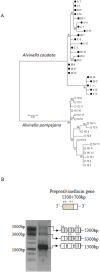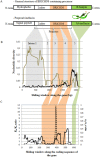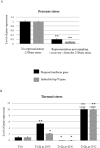Antagonistic evolution of an antibiotic and its molecular chaperone: how to maintain a vital ectosymbiosis in a highly fluctuating habitat
- PMID: 28469247
- PMCID: PMC5431198
- DOI: 10.1038/s41598-017-01626-2
Antagonistic evolution of an antibiotic and its molecular chaperone: how to maintain a vital ectosymbiosis in a highly fluctuating habitat
Erratum in
-
Author Correction: Antagonistic evolution of an antibiotic and its molecular chaperone: how to maintain a vital ectosymbiosis in a highly fluctuating habitat.Sci Rep. 2017 Dec 4;7(1):17154. doi: 10.1038/s41598-017-16211-w. Sci Rep. 2017. PMID: 29203774 Free PMC article.
Abstract
Evolution of antimicrobial peptides (AMPs) has been shown to be driven by recurrent duplications and balancing/positive selection in response to new or altered bacterial pathogens. We use Alvinella pompejana, the most eurythermal animal known on Earth, to decipher the selection patterns acting on AMP in an ecological rather than controlled infection approach. The preproalvinellacin multigenic family presents the uniqueness to encode a molecular chaperone (BRICHOS) together with an AMP (alvinellacin) that controls the vital ectosymbiosis of Alvinella. In stark contrast to what is observed in the context of the Red queen paradigm, we demonstrate that exhibiting a vital and highly conserved ecto-symbiosis in the face of thermal fluctuations has led to a peculiar selective trend promoting the adaptive diversification of the molecular chaperone of the AMP, but not of the AMP itself. Because BRICHOS stabilizes beta-stranded peptides, this polymorphism likely represents an eurythermal adaptation to stabilize the structure of alvinellacin, thus hinting at its efficiency to select and control the epibiosis across the range of temperatures experienced by the worm; Our results fill some knowledge gaps concerning the function of BRICHOS in invertebrates and offer perspectives for studying immune genes in an evolutionary ecological framework.
Conflict of interest statement
The authors declare that they have no competing interests.
Figures





Similar articles
-
Novel Antimicrobial Peptides from the Arctic Polychaeta Nicomache minor Provide New Molecular Insight into Biological Role of the BRICHOS Domain.Mar Drugs. 2018 Oct 23;16(11):401. doi: 10.3390/md16110401. Mar Drugs. 2018. PMID: 30360541 Free PMC article.
-
Characterization and function of the first antibiotic isolated from a vent organism: the extremophile metazoan Alvinella pompejana.PLoS One. 2014 Apr 28;9(4):e95737. doi: 10.1371/journal.pone.0095737. eCollection 2014. PLoS One. 2014. PMID: 24776651 Free PMC article.
-
Insights into metazoan evolution from Alvinella pompejana cDNAs.BMC Genomics. 2010 Nov 16;11:634. doi: 10.1186/1471-2164-11-634. BMC Genomics. 2010. PMID: 21080938 Free PMC article.
-
Molecular evolution of animal antimicrobial peptides: widespread moderate positive selection.J Evol Biol. 2005 Nov;18(6):1387-94. doi: 10.1111/j.1420-9101.2005.00925.x. J Evol Biol. 2005. PMID: 16313451 Review.
-
Molecular strategies in biological evolution of antimicrobial peptides.Peptides. 2003 Nov;24(11):1669-80. doi: 10.1016/j.peptides.2003.08.017. Peptides. 2003. PMID: 15019198 Review.
Cited by
-
Abilities of the BRICHOS domain to prevent neurotoxicity and fibril formation are dependent on a highly conserved Asp residue.RSC Chem Biol. 2022 Sep 15;3(11):1342-1358. doi: 10.1039/d2cb00187j. eCollection 2022 Nov 2. RSC Chem Biol. 2022. PMID: 36349220 Free PMC article.
-
Novel Antimicrobial Peptides from the Arctic Polychaeta Nicomache minor Provide New Molecular Insight into Biological Role of the BRICHOS Domain.Mar Drugs. 2018 Oct 23;16(11):401. doi: 10.3390/md16110401. Mar Drugs. 2018. PMID: 30360541 Free PMC article.
-
Worms' Antimicrobial Peptides.Mar Drugs. 2019 Aug 29;17(9):512. doi: 10.3390/md17090512. Mar Drugs. 2019. PMID: 31470685 Free PMC article. Review.
-
Aquatic Invertebrate Antimicrobial Peptides in the Fight Against Aquaculture Pathogens.Microorganisms. 2025 Jan 14;13(1):156. doi: 10.3390/microorganisms13010156. Microorganisms. 2025. PMID: 39858924 Free PMC article. Review.
-
Novel BRICHOS-Related Antimicrobial Peptides from the Marine Worm Heteromastus filiformis: Transcriptome Mining, Synthesis, Biological Activities, and Therapeutic Potential.Mar Drugs. 2023 Dec 14;21(12):639. doi: 10.3390/md21120639. Mar Drugs. 2023. PMID: 38132960 Free PMC article.
References
Publication types
MeSH terms
Substances
LinkOut - more resources
Full Text Sources
Other Literature Sources

